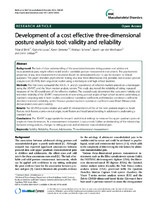| dc.contributor.author | Brink, Yolandi | |
| dc.contributor.author | Louw, Quinette | |
| dc.contributor.author | Grimmer, Karen | |
| dc.contributor.author | Schreve, Kristiaan | |
| dc.contributor.author | van der Westhuizen, Gareth | |
| dc.contributor.author | Jordaan, Esme | |
| dc.date.accessioned | 2016-09-02T14:38:54Z | |
| dc.date.available | 2016-09-02T14:38:54Z | |
| dc.date.issued | 2013 | |
| dc.identifier.citation | Brink et al. (2013). Development of a cost effective three-dimensional posture analysis tool: validity and reliability. BMC Musculoskeletal Disorders, 14: 335 | en_US |
| dc.identifier.issn | 1471-2474 | |
| dc.identifier.uri | http://hdl.handle.net/10566/2395 | |
| dc.description.abstract | BACKGROUND: The lack of clear understanding of the association between sitting posture and adolescent
musculoskeletal pain, might reflect invalid and/or unreliable posture measurement instruments. The psychometric
properties of any new measurement instrument should be demonstrated prior to use for research or clinical
purposes. This paper describes psychometric testing of a new three-dimensional (3D), portable, non-invasive posture
analysis tool (3D-PAT), from sequential studies using a mannequin and high school students.
METHODS: The first study compared the 3D-(X-, Y- and Z-) coordinates of reflective markers placed on a mannequin
using the 3D-PAT, and the Vicon motion analysis system. This study also tested the reliability of taking repeated
measures of the 3D-coordinates of the reflective markers. The second study determined the concurrent validity and
test-retest reliability of the 3D-PAT measurements of nine sitting postural angles of high school students undertaking a
standard computing task. In both studies, concordance correlation coefficients and Intraclass correlation coefficients
described test-retest reliability, whilst Pearson product moment correlation coefficients and Bland-Altman plots
demonstrated concurrent validity.
RESULTS: The 3D-PAT provides reliable and valid 3D measurements of five of the nine postural angles i.e. head
flexion, neck flexion, cranio-cervical angle, trunk flexion and head lateral bending in adolescents undertaking a
standard task.
CONCLUSIONS: The 3D-PAT is appropriate for research and clinical settings to measure five upper quadrant postural
angles in three dimensions. As a measurement instrument it can provide further understanding of the relationship
between sitting posture, changes to sitting posture and adolescent musculoskeletal pain. | en_US |
| dc.language.iso | en | en_US |
| dc.publisher | BioMed Central | en_US |
| dc.rights | © 2013 Brink et al.; licensee BioMed Central Ltd. This is an open access article distributed under the terms of the Creative
Commons Attribution License (http://creativecommons.org/licenses/by/2.0), which permits unrestricted use, distribution, and reproduction in any medium, provided the original work is properly cited. | |
| dc.source.uri | http://dx.doi.org/10.1186/1471-2474-14-335 | |
| dc.subject | Musculoskeletal pain | en_US |
| dc.subject | Musculoskeletal disorders | en_US |
| dc.subject | Musculoskeletal injury | en_US |
| dc.subject | Adolescents | en_US |
| dc.subject | Measurement | en_US |
| dc.title | Development of a cost effective three-dimensional posture analysis tool: validity and reliability | en_US |
| dc.type | Article | en_US |
| dc.description.accreditation | Web of Science | |

